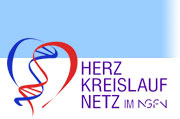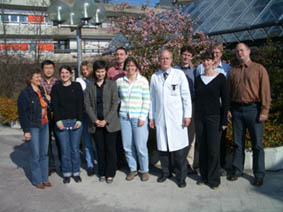 » Barrier-free View
» Barrier-free View
| ||||||||
 | ||||||||
 |
 |
 |
| Picture of the 1st Network Meeting of the Herz-Kreislauf-NetzDownloadsArchivExternal job opportunities |
 |
Inflammation and immune response in the pathogenesis of typ 2 diabetes and atherosclerosis: Testing the common soil hypothesis
| Subproject leader
Prof. Dr. Wolfgang Koenig
Department of Internal Medicine II University of Ulm 89081 Ulm email: wolfgang.koenig@medizin.uni-ulm.de Phone: 0731-500 24441
|
Type 2 diabetes mellitus (T2DM) has long been recognized as a powerful and independent risk factor for atherosclerosis and its complications. Indeed, atherosclerosis in diabetic patients progresses faster than in non-diabetic subjects, reflected in part by the fact that patients with T2DM have earlier and more severe coronary heart disease (CHD). In addition, patients with T2DM without previous myocardial infarction (MI) have an equivalent risk to develop a first MI compared to non-diabetic patients who have had a previous MI. However, it has also be suggested that atherosclerosis possibly precedes the development of diabetes, and this assumption has led to a common soil hypothesis, postulating that diabetes and atherosclerosis not only happily coexist but rather arise from common genetic and environmental roots (Fig.1). In fact, CHD and T2DM share several established causal risk factors, such as insulin resistance, elevated triglycerides, low HDL-cholesterol, increased small dense LDL particles, hypertension, endothelial dysfunction, a prothrombotic state, as well as abdominal or visceral obesity. A clustering of such risk factors has been labeled the metabolic syndrome (MS).
 |
Fig 1: Common Soil Hypothesis. |
Although pathophysiological abnormalities underlying these complex diseases remain to be entirely elucidated, activation of the immune system with subsequent low-grade inflammatory response may play a pivotal role as a possible mechanism linking atherosclerosis and metabolic disorders. Several studies have shown that elevated levels of inflammatory and endothelial cell markers, such as C-reactive protein (CRP), several cytokines and cellular adhesion molecules (CAMs) independently predict both CHD and diabetes. Since a chronic low-grade inflammation seen in the MS, T2DM and in atherosclerosis may be related to common genetic predisposition and environmental risk factors, modulation of the systemic immune balance through gene polymorphisms might play a crucial role. Therefore, we sought to investigate the association between genetic variants in genes encoding [for] inflammatory markers, markers of endothelial dysfunction and T2DM and CHD within three different populations. This approach will allow us to focus on several, complementary aspects related to this topic
Topic1:
Inflammation and endothelial dysfunction as a common cause underlying T2DM and myocardial infarction. Role of intermediate phenotypes and genetic variants.
Based on data from the MONICA/KORA Augsburg studies, and co-funded by the DFG (FKZ TH 784/2-1), we conducted a prospective case-cohort study in initially healthy, middle
aged men and women between 1984 and 2002. Due to the simultaneous assessment of T2DM and CHD events in the same study cohort, this study design offers the unique opportunity to investigate the role of genetic variants in genes encoding for inflammatory markers, markers of the natural immune system, and markers of endothelial dysfunction relevant in the pathophysiology of diabetes and clinical complications of atherosclerosis.
The MONICA Augsburg project (Monitoring of Trends and Determinants in Cardiovascular Disease) has been part of the multinational WHO MONICA project (Fig. 2). Three independent population-based surveys covering the city area of Augsburg and two adjacent counties, were conducted in 1984/85 (S1), 1989/90 (S2) and 1994/95 (S3) to estimate the prevalence and distribution of cardiovascular risk factors among men and women aged 25 to 64 (S1) or 25 to 74 years (S2, S3) (Fig. 2). A total number of 13,427 individuals (6,725 men and 6,702 women) participated in at least one of the three surveys. Standardized interviews were conducted by trained medical staff (mainly nurses) to assess information concerning sociodemographic variables, smoking habits, leisure-time physical activity level, alcohol consumption and parental history of T2DM and CHD. In addition, participants underwent standardized medical examinations including collection of a venous blood sample. Within the frame of the KORA (Cooperative Research in the Region of Augsburg/ KOoperative Gesundheitsforschung im Raum Augsburg) program, a written follow-up (FU) questionnaire was sent to all former participants in 1998 and in 2002/03 to obtain information concerning the occurrence of chronic diseases and risk factors. For deceased subjects information on causes of death was obtained. CHD endpoints were identified through the population-based MI registry.
 |
Fig 2: Overview of MONICA/KORA Augsburg Cohort Studies |
All subjects aged 25-34 years were excluded from the case-cohort study because events are low in this age range. Altogether, 10,718 persons (5,382 men and 5,336 women) between 35 and 74 years at baseline participated in at least one of the three surveys. After exclusion of 1,187 subjects with missing blood samples, the source population comprised 9,531 subjects (4,696 men and 4,835 women). Participants with self-reported prevalent DM, without FU information or with a FU period of less than one year were further excluded from the study which resulted in a cohort of interest comprising 7,936 subjects (3,894 men; 4,042 women) if T2DM as outcome variable was investigated. For incident CHD, the cohort of interest consisted of 9,300 subjects (4,507 men; 4,793 women). For the case-cohort study, a stratified random sample of the source population, called here the sub-cohort, was selected stratified by sex and survey and contained 1,885 subjects (1,018 men, 867 women) for DM and 2,163 (1,154 men and 1,009 women) for CHD events. The final stratum-specific sample sizes were used together with the stratum-specific sizes of the cohort of interests to compute sampling fractions, and the inverse of the sampling fractions yielded the survey- and sex-specific sampling weights. A total of 555 (329 men, 226 women) incident cases of T2DM and 397 (307 men, 90 women) incident CHD cases (non-fatal and fatal MI and coronary death) were observed between participants baseline examination and December 31st, 2002. The mean FU time for the study population was 10.8 (±5.1) years for T2DM and 11.0 (±5.0) years for CHD events.
 |
Fig. 3 MONICA/KORA Case-Cohort Study 1984-2002 a) T2DM as disease outcome b) CHD as disease outcome |
The results of this prospective population-based cohort may contribute to our understanding of the association between T2DM and coronary events, since the importance of genetic variants in the etiology of both diseases can be directly compared. The possibility to investigate gene-environment interactions between various single nucleotide polymorphisms (SNPs) and a number of behavioral risk factors collected in a standardized manner in this cohort presents another hallmark of this study. Furthermore, gender differences can be analyzed due to the large number of cases. In addition to the analysis of disease outcomes, the association between genetic variants and corresponding serum/plasma levels of various biomarkers reflecting the inflammatory immune response and endothelial dysfunction can be studied. Subjects from our population-based samples may serve as controls for various partners in the network.
For the case-cohort study we decided to carefully analyze SNPs of relevant frequencies in the candidate genes to ensure a good coverage of the genes. All SNPs which were previously associated with cardiovascular traits or T2DM or with related intermediate phenotypes (e.g. plasma levels) would be genotyped first. The candidate genes of first choice are the acute-phase reactant CRP, the cytokines IL-6 and IL-18, the chemokines IL-8, IP10, MCP-1, MIF, Rantes and the adhesion molecules [s]ICAM-1 and E-selectin. Candidate genes of second choice are APM1, LTA, TLR4, IL-10 and resistin. For all selected first choice genes blood serum protein levels were measured in the surveys and the genes are involved in inflammatory pathways. Out of 60 selected SNPs from 10 candidate genes of first choice, 16 SNPs have been genotyped and are currently subjected to statistical analysis.
Topic 2:
Systematic analysis of gene polymorphisms of the natural (not adaptive) immune system and association with type 2 diabetes and markers of inflammation.
Complementary to the first study, in the second population we attempt to establish an extensive profile of DNA variants associated with an increased risk of glucose disorders (impaired glucose tolerance, T2DM) and chronic inflammation. Therefore, the primary aims of this subproject are to assess 1. Whether or not the expression of immune markers e.g. chemokines, cytokines, or acute phase proteins is determined by DNA variants; 2. Whether polymorphisms in selected candidate genes which are involved in inflammatory processes, are associated with pre- and manifest T2DM. The population included in this cross-sectional study is based on the KORA survey 2000 (S4) (Fig.2), and is well characterized for the presence or absence of insulin resistance (oral glucose tolerance test (OGTT), insulin measurements). The KORA survey 2000, being a representative sample of the adult general population of German nationality, was recruited from October 1999 to April 2001 and comprised 4,261 men and women between 25 and 74 years of age with a response rate of 67%. Among them, 1,653 persons aged 55 to 74 years participated in a standardized interview followed by biochemical and clinical analyses. CHD was assessed by the Rose questionnaire and by self-reports of past MI. All individuals without a known history of DM underwent a standardized OGTT. Subjects with impaired glucose tolerance (IGT) and newly diagnosed T2DM have been identified following current WHO criteria. A total of 236 individuals with T2DM and 242 individuals with IGT were available for analyses. 244 normoglycemic controls were randomly selected after frequency matching for age and gender. In addition, all subjects (n=722) have been analyzed genetically. Moreover, within the frame of the KORA Augsburg program, a FU is ongoing to obtain information concerning the occurrence of chronic diseases and risk factors. For deceased subjects information on causes of death will be obtained.
The discovery of new risk alleles may enable us to identify new important metabolic and immunological pathways potentially leading to innovative therapeutic strategies. The population-based approach and the detailed metabolic characterization of subjects represent the strength of this study. Such phenotypes from a representative sample of the general population are not available from other partners of the net. We have already selected and genotyped the candidate genes and the SNPs therein for subproject number 2. For the following candidate genes one to several SNPs have been genotyped on the Sequenom MALDI-TOF system: CCR1, CCR2, CCR3, CCR5, Eotaxin, IL-13, IL-18, IL-10, IL-6, IL6R, IP10, MCP1, MIF, APOA5, APM1, CAPN10, HNF4-a, NFkB1, NOD1, NOD2, CRP, TNF-a.
Topic 3:
Inflammation and hemostasis in stable coronary artery disease: A gene array approach.
In a third, also well characterized large case-control study, we try to assess simultaneously a large panel of gene variants of relevant phenotypes and intermediate phenotypes (biomarkers) in atherosclerosis by means of a gene array approach. This study, initially implemented to test the hypothesis whether or not seropositivity to various agents is associated with chronic stable coronary artery disease (CAD), comprises 312 angiographically defined cases with CAD and 479 age- and sex-matched healthy blood donors from the same geographical region. A 4 year follow-up in cases has been carried out. Patients and controls are well characterized with regard to demographic variables and a large panel of lipid markers, markers of endothelial function, inflammation and hemostasis has been measured. The specification of SNP analysis by PCR and chip technologies is followed to screen large numbers of DNA samples. Based on a gene array approach, linkage analysis may enable us to identify susceptibility loci in certain chromosomes. We also expect individual risk associations related to the initiation of the low-grade inflammatory condition. The detailed demographic and biochemical characterization represent the strength of this study. The establishment of a specific risk profile is of particular interest in this context. Results may be replicated in independent samples from other projects in the net.
In subproject 3, SNP selection (altogether 15 SNPs) has already been performed for the following genes: P2X7, FcgRIIA, FcgRIIIA, TLR-4, PAF-AH (PLA2G7), IL-1b, IL-1RA and IL-6. In this population, the first SNP genotyping for PLA2G7 has been done and the genotyping for P2X7 is underway.
We expect to complete genotyping for all three subprojects by the end of 2005. However, we have already started statistical analysis of SNPs of several candidate genes, in particular CRP and IL-6. First results will be presented at the NGFN-2 Meeting in November 2005.
additional pictures and information ->
 |
Working group Prof. Koenig |
more information about the working group:
http://www.uni-ulm.de/klinik/medklinik/innere2/veranstaltungen.html
